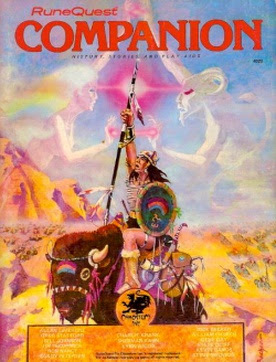Retrospective: RuneQuest Companion
 About a year after the publication of original Dungeons & Dragons, its first supplement appeared. Subtitled Greyhawk, Supplement I offered up a grab bag of "new characters, new abilities, more spells to use, a horde of new monsters, heaps of new magical treasure, and various additions to the suggestions and rules for adventuring above and below the ground," most of which were drawn from Gary Gygax's D&D campaign of the same name. Two more supplements of a similar sort followed (Blackmoor and Eldritch Wizardry), thereby establishing a pattern for the way rules additions and suggestions were published in the hobby.
About a year after the publication of original Dungeons & Dragons, its first supplement appeared. Subtitled Greyhawk, Supplement I offered up a grab bag of "new characters, new abilities, more spells to use, a horde of new monsters, heaps of new magical treasure, and various additions to the suggestions and rules for adventuring above and below the ground," most of which were drawn from Gary Gygax's D&D campaign of the same name. Two more supplements of a similar sort followed (Blackmoor and Eldritch Wizardry), thereby establishing a pattern for the way rules additions and suggestions were published in the hobby.Chaosium was particularly prolific in producing supplements of this sort, though, rather than calling them "supplements," they called them "companions." Companions were published to support most of their RPGs, from Call of Cthulhu to Stormbringer to Ringworld, among others. Each of these companions presented a selection of rules and setting additions, expansions, options, and corrections. I've always appreciated this approach, since it both obviates the need for a new edition and gave the referee the choice of whether or not to include any of the new material printed in its pages.The RuneQuest Companion, first published in 1983, is a good example of what I mean. Over the course of 72 pages, the Companion presents nineteen articles by a wide variety of authors, each of which offers new insight into some aspect of RQ and its setting, Glorantha. As explained by Charlie Krank in his introduction to the book, the Companion was published in the wake of the cancelation of Wyrms Footnotesm the semi-regular 'zine that had previously provided RQ fans with more information about Glorantha and its history, cultures, and denizens. (It's interesting to note that Krank's explanation for the demise of Wyrms Footnotes is quite simple: "it costs too much money." As the publisher of a fanzine myself, I am deeply sympathetic with Krank's perspective.) The Companion, then, was intended to fill this particular gap, with the promise – unfulfilled, as it turned out, but then that's nothing new in the history of RuneQuest – of a new volume of the Companion "whenever we have accumulated 64–96 pages of top-notch articles."
The articles are quite varied. There's Sherman Kahn's "An Index to RuneQuest Cults," Alan LaVergne's solo adventure, "The Maze of Shaxry Oborok," and Greg Stafford's "Holy Country" (complete with a remarkable map). Meanwhile, Sandy Petersen presents his "Species Spotlight: Unicorns," which gives a unique Gloranthan spin on the legendary beasts and "More on Trolls," expanding on the information in Trollpak. There's also a fair bit of fiction (and poetry) set in Glorantha and few rules additions. What makes the Companion remarkable, though, is its diversity. Its pages aren't devoted to a single theme or topic. Instead, we're provided with articles and essays on many aspects of the game and its setting, with a particular emphasis on the latter. Indeed, looking back on it now, what really strikes me about the RuneQuest Companion is how few of its pages are devoted to new rules. Chaosium clearly understood the main draw of RQ was its setting of Glorantha. That's probably why I look on this book so favorably even now.
Published on November 03, 2021 09:56
No comments have been added yet.
James Maliszewski's Blog
- James Maliszewski's profile
- 3 followers
James Maliszewski isn't a Goodreads Author
(yet),
but they
do have a blog,
so here are some recent posts imported from
their feed.



